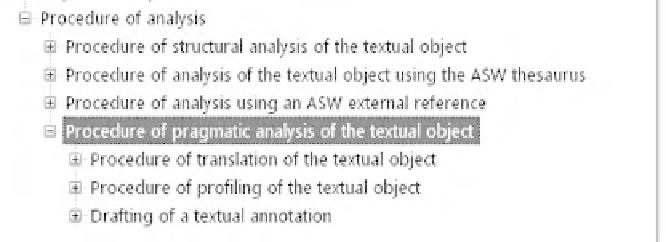Information Technology Reference
In-Depth Information
references. Time will tell how this class of analytical activity evolves. Besides the
particular case of the LOMFR standard, for now (as Figure 14.6 shows), we are
primarily interested in providing the analyst with the option of carrying out
descriptions of audiovisual content which is likely to be (re-)diffused on the major
portals for sharing cultural and scientific heritage, which often integrate standards
such as
DublinCore
or OAI.
14.6. The class of activities [Procedure of pragmatic analysis of the textual
object]
Finally, Figure 14.9 shows the three main groups of analytical activity which
make up the taxonomic domain [Procedure of pragmatic analysis of the textual
object]. Under the umbrella of the conceptual term [Procedure of translation of the
textual object], we classify all activities which serve to render an audiovisual text
accessible to an audience who do not possess the linguistic skills needed to
understand it.
As we have already explained in previous publications ([STO 08] and [STO 10]),
this is a question of opening up an audiovisual text which is usually monolingual to
a “knowledge market” that, for its part, is intrinsically multilingual. This does not
necessarily entail producing professional translations (in the form of dubbing,
subtitling, etc.) for every audiovisual text - which, at least from a financial
standpoint, is practically impossible. Rather, it involves offering
linguistic mediation
services such as relay translation or
communal translation
, enabling an analyst/
translator, in the language of the target audience, to produce explanatory notes and
summaries, translations in the
telegraphic
sense, or more or less free versions.
5
Figure14.9.
Theprocedureofpragmaticanalysisofthetextualobject
5 Concrete examples are to be found on the ARA (Audiovisual Research Archives) website:
http://www.archivesaudiovisuelles.fr/FR/BilingualFolders.asp.

